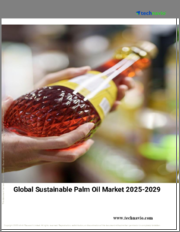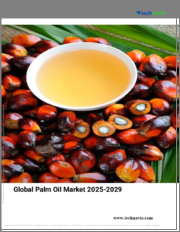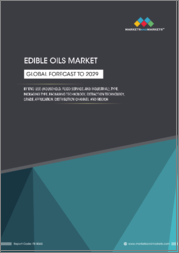
|
시장보고서
상품코드
1347147
세계의 팜유 시장(2016-2030년) : 유형, 재배, 용도, 최종 이용 산업별, 지역별 기회 및 예측Palm Oil Market Assessment, By Type, By Cultivation, By Application, By End-use Industry, By Region, Opportunities, and Forecast, 2016-2030F |
||||||
세계 팜유 시장 규모는 2022년 588억 달러에서 예측 기간 동안 4.2%의 CAGR을 기록하며 2030년에는 817억 달러 규모로 성장할 것으로 예상됩니다.
세계 인구의 증가와 경제 성장으로 식용유에 대한 수요는 계속 증가하고 있으며, 팜유는 다양한 식품에 광범위하게 사용되고 있습니다. 또한, 팜유를 포함한 바이오 연료의 통합을 촉진하려는 정부의 노력은 이 분야에 새로운 중요성을 부여하고 있습니다. 화석연료에 대한 의존도를 낮추고 탄소 배출을 줄이기 위해 재생 가능한 에너지 자원으로서 팜유의 잠재력은 정책 입안자와 다양한 산업계의 뜨거운 관심을 받고 있습니다.
세계 팜유 시장은 예측할 수 없는 날씨와 질병 발생으로 인한 공급 변동에 직면해 있습니다. 또한, 삼림 벌채와 재배 환경의 악화, 팜유 생산의 윤리적 측면에 대한 우려의 증가, 다른 오일의 가용성, 무역 규칙, 통화 가치 변동 등의 영향으로 팜유 산업은 예측할 수 없는 요소들이 많아지고 있습니다. 그러나 RSPO(Roundtable on Sustainable Palm Oil)와 같은 이니셔티브는 시장의 긍정적인 전망에 기여하는 큰 모멘텀을 모으고 있습니다.
세계 팜유 시장을 조사했으며, 시장 정의와 개요, 시장 규모 추이 및 예측, 각종 부문별·지역별 상세 분석, 산업 구조, 시장 성장에 영향을 미치는 요인 분석, 사례 연구, 경쟁 상황, 주요 기업 개요 등의 정보를 정리하여 전해드립니다.
목차
제1장 조사 방법
제2장 프로젝트 범위와 정의
제3장 COVID-19별 팜유 시장에 대한 영향
제4장 러시아·우크라이나 전쟁의 영향
제5장 주요 요약
제6장 고객의 소리
- 시장 인식과 제품 정보
- 브랜드 인지도와 로열티
- 구입 결정시에 고려되는 요소
- 구입 빈도
- 구입 매체
제7장 세계의 팜유 시장 전망
- 시장 규모와 예측
- 유형별
- 팜원유
- 팜핵유
- 분획 팜유
- 화이트 팜유
- 버진 팜유
- RBD 팜유
- 기타
- 재배 구분별
- 유기농
- 기존
- 용도별
- 화학 원료
- 바이오연료 생산
- 동물 사료
- 기타
- 최종 이용 산업별
- 의약품
- 식품·음료
- 화장품
- 화학처리
- 축산
- 기타
- 지역별
- 북미
- 유럽
- 남미
- 아시아태평양
- 중동 및 아프리카
제8장 세계의 팜유 시장 전망 : 지역별
- 북미
- 유럽
- 남미
- 아시아태평양
- 중동 및 아프리카
제9장 공급측 분석
- 제조능력 : 기업별
- 제조량 : 기업별
- 가동 효율 : 기업별
- 주요 공장 소재지
제10장 시장 매핑
- 유형별
- 재배 구분별
- 용도별
- 최종 이용 산업별
- 지역별
제11장 거시적 환경·산업 구조
- 수급 분석
- 수출입 분석
- 공급망/밸류체인 분석
- PESTEL 분석
- Porter's Five Forces 분석
제12장 시장 역학
- 성장 추진요인
- 성장 억제요인(과제·제약)
제13장 주요 기업 상황
- 시장 리더 상위 5개사 경쟁 매트릭스
- 시장 리더 상위 5개사 시장 매출 분석
- M&A(해당되는 경우)
- SWOT 분석(참여 5개사)
- 특허 분석(해당되는 경우)
제14장 가격 분석
제15장 사례 연구
제16장 주요 기업 전망
- Wilmar International Ltd
- Kuala Lumpur Kepong Berhad
- FGV Holdings Berhad
- Cargill Inc
- IOI Group Berhad
- Asian Agri
- Olam International
- Sime Darby Plantation
- Posco International Corporation
- Golden Agri-Resources Ltd
제17장 전략적 제안
제18장 당사 소개와 면책사항
ksm 23.09.22Global palm oil market size was valued at USD 58.8 billion in 2022, which is expected to grow to USD 81.7 billion in 2030, with a CAGR of 4.2% during the forecast period, between 2023 and 2030. The upsurge in global population and economic expansion propels an ever-mounting appetite for edible oils, with palm oil emerging as a pervasive component within a wide spectrum of food products. Additionally, governmental endeavors to foster the integration of biofuels, including those sourced from palm oil, have introduced an additional stratum of significance to this sector. In a collective endeavor to diminish dependence on fossil fuels and abate carbon emissions, the potential of palm oil as a renewable energy resource has garnered the rapt attention of policymakers and various industries.
The global palm oil market faces fluctuations in supply due to unpredictable weather and disease outbreaks. The market is affected by the availability of other oils, trade rules, and changes in currency values along with growing apprehensions concerning deforestation, habitat degradation, and the ethical dimensions associated with palm oil production, all adding a layer of unpredictability to the palm oil industry. However, initiatives such as the Roundtable on Sustainable Palm Oil (RSPO) have garnered substantial momentum contributing to a positive market outlook.
Growing Demand for Biofuel
Palm oil serves as a vital feedstock in biodiesel production, a renewable energy source that holds significant promise in the global pursuit of sustainable alternatives to fossil fuels. The utilization of palm oil as a primary ingredient in biodiesel formulation has gained traction, driven in large parts by government policies and incentives aimed at advancing the adoption of renewable energy sources.
For instance, in a bid to decrease its reliance on imported diesel fuel in the face of soaring global energy costs and to curb emissions, Indonesia, the largest global palm oil producer has taken the significant step of increasing the mandatory palm oil blend in biodiesel. Since February 2023, the required blending ratio of palm oil in biofuel has been elevated from 30% to a new benchmark of 35%. Government initiatives like these towards biofuel development drive the demand for palm oil globally.
Rising Sustainable Practices
Growing concerns about the decrementing environmental and social impacts associated with palm oil production have significantly altered the industry landscape. Deforestation, habitat destruction, and human rights violations have cast a shadow on conventional palm oil practices, prompting a widespread call for change. This shift in public sentiment has created a heightened demand for palm oil that is sourced and produced in a manner that mitigates these negative consequences.
In response to these concerns, certification programs like the Roundtable on Sustainable Palm Oil (RSPO) have emerged as vital mechanisms for driving responsible production practices within the palm oil sector. The RSPO, as a leading example, sets forth stringent standards and guidelines that producers must adhere to attain certification. These criteria include environmental conservation, land use, labor rights, and community engagement. These rules address consumer concerns and promote consumption raising demand for palm oil.
Impact of COVID-19
The COVID-19 had mixed effects on the global palm oil market. The market faced challenges due to supply shortages, demand differences, and logistical problems. Industries such as chemical processing were affected by market restrictions, lowering the demand for palm oil. The decreased cultivation of palm during COVID-19 owing to labor restriction weakened the market's supply side. However, there were positive impacts on global palm oil market caused by the increased demand from sectors like pharmaceuticals and personal care. The need for personal care and hygiene items peaked during the pandemic which led to an increased demand for palm oil globally.
Impact of Russia-Ukraine War
The ongoing conflict between Russia and Ukraine did not directly impact the palm oil market. However, Ukraine was the highest sunflower oil exporting country, and the war has disrupted the supply of sunflower oil. Therefore, the demand for substitute oils, such as palm oil peaked at the beginning of the conflict. Moreover, the conflict between Russia and Ukraine has led to market instability and trade disruptions worldwide. Global palm oil manufacturers face challenges due to delays and uncertainty in supply chains resulting from the ongoing war.
Key Players Landscape and Outlook
Major palm oil manufacturers are strategically pursuing acquisitions to diversify their downstream product portfolios and extend their market presence. These efforts align with the overarching objective of expanding their offerings beyond the core palm oil segment, thus enhancing their market positioning and diversifying revenue streams. These manufacturers aim to capitalize on synergistic opportunities through targeted acquisitions, leverage economies of scale, and optimize operational efficiencies across a broader spectrum of products and markets.
For instance, in April 2023, Kuala Lumpur Kepong Bhd (KL Kepong), operating through its resource-based manufacturing division named KLK Oleo, successfully finalized the acquisition of a majority share in Temix Oleo SpA.
A dual landscape of challenges and opportunities shapes the global palm oil market's future. Sustainability concerns and ethical practices will reshape industry norms, driven by consumer demand and regulations. Initiatives like RSPO will gain prominence. Simultaneously, growing global population and demand for versatile palm oil applications in food, personal care, and biofuels will persist. Technological advancements and renewable energy shifts will further drive palm oil's growth. However, trade dynamics, changing preferences, and regulations pose challenges. Striking a balance between demand, sustainability, and innovation will be crucial for long-term success.
Table of Contents
1. Research Methodology
2. Project Scope & Definitions
3. Impact of COVID-19 on Palm Oil Market
4. Impact of Russia-Ukraine War
5. Executive Summary
6. Voice of Customer
- 6.1. Market Awareness and Product Information
- 6.2. Brand Awareness and Loyalty
- 6.3. Factors Considered in Purchase Decision
- 6.3.1. Brand Name
- 6.3.2. Quality
- 6.3.3. Quantity
- 6.3.4. Price
- 6.3.5. Product Specification
- 6.3.6. Application Specification
- 6.3.7. VOC/Toxicity Content
- 6.3.8. Shelf Life
- 6.3.9. Availability of Product
- 6.4. Frequency of Purchase
- 6.5. Medium of Purchase
7. Global Palm Oil Market Outlook, 2016-2030F
- 7.1. Market Size & Forecast
- 7.1.1. By Value
- 7.1.2. By Volume
- 7.2. By Type
- 7.2.1. Crude palm oil
- 7.2.2. Palm kernel oil
- 7.2.3. Fractionated palm oil
- 7.2.4. White palm oil
- 7.2.5. Virgin palm oil
- 7.2.6. RBD palm oil
- 7.2.7. Others
- 7.3. By Cultivation
- 7.3.1. Organic
- 7.3.2. Conventional
- 7.4. By Application
- 7.4.1. Chemical Feedstock
- 7.4.2. Biofuel Production
- 7.4.3. Animal Feed
- 7.4.4. Others
- 7.5. By End-use Industry
- 7.5.1. Pharmaceuticals
- 7.5.2. Food & Beverages
- 7.5.3. Cosmetics
- 7.5.4. Chemical Processing
- 7.5.5. Animal Husbandry
- 7.5.6. Others
- 7.6. By Region
- 7.6.1. North America
- 7.6.2. Europe
- 7.6.3. South America
- 7.6.4. Asia-Pacific
- 7.6.5. Middle East and Africa
8. Global Palm Oil Market Outlook, By Region, 2016-2030F
- 8.1. North America*
- 8.1.1. By Type
- 8.1.1.1. Crude palm oil
- 8.1.1.2. Palm kernel oil
- 8.1.1.3. Fractionated palm oil
- 8.1.1.4. White palm oil
- 8.1.1.5. Virgin palm oil
- 8.1.1.6. RBD palm oil
- 8.1.1.7. Others
- 8.1.2. By Cultivation
- 8.1.2.1. Organic
- 8.1.2.2. Conventional
- 8.1.3. By Application
- 8.1.3.1. Chemical Feedstock
- 8.1.3.2. Biofuel Production
- 8.1.3.3. Animal Feed
- 8.1.3.4. Others
- 8.1.4. By End-use Industry
- 8.1.4.1. Pharmaceuticals
- 8.1.4.2. Food & Beverages
- 8.1.4.3. Cosmetics
- 8.1.4.4. Chemical Processing
- 8.1.4.5. Animal Husbandry
- 8.1.4.6. Others
- 8.1.5. United States*
- 8.1.5.1. By Type
- 8.1.5.1.1. Crude palm oil
- 8.1.5.1.2. Palm kernel oil
- 8.1.5.1.3. Fractionated palm oil
- 8.1.5.1.4. White palm oil
- 8.1.5.1.5. Virgin palm oil
- 8.1.5.1.6. RBD palm oil
- 8.1.5.1.7. Others
- 8.1.5.2. By Cultivation
- 8.1.5.2.1. Organic
- 8.1.5.2.2. Conventional
- 8.1.5.3. By Application
- 8.1.5.3.1. Chemical Feedstock
- 8.1.5.3.2. Biofuel Production
- 8.1.5.3.3. Animal Feed
- 8.1.5.3.4. Others
- 8.1.5.4. By End-use Industry
- 8.1.5.4.1. Pharmaceuticals
- 8.1.5.4.2. Food & Beverages
- 8.1.5.4.3. Cosmetics
- 8.1.5.4.4. Chemical Processing
- 8.1.5.4.5. Animal Husbandry
- 8.1.5.4.6. Others
- 8.1.1. By Type
All segments will be provided for all regions and countries covered:
- 8.1.6. Canada
- 8.1.7. Mexico
- 8.2. Europe
- 8.2.1. Germany
- 8.2.2. France
- 8.2.3. Italy
- 8.2.4. United Kingdom
- 8.2.5. Russia
- 8.2.6. Netherlands
- 8.2.7. Spain
- 8.2.8. Turkey
- 8.2.9. Poland
- 8.3. South America
- 8.3.1. Brazil
- 8.3.2. Argentina
- 8.4. Asia-Pacific
- 8.4.1. India
- 8.4.2. China
- 8.4.3. Japan
- 8.4.4. Australia
- 8.4.5. Vietnam
- 8.4.6. South Korea
- 8.4.7. Indonesia
- 8.4.8. Philippines
- 8.5. Middle East & Africa
- 8.5.1. Saudi Arabia
- 8.5.2. UAE
- 8.5.3. South Africa
9. Supply Side Analysis
- 9.1. Capacity, By Company
- 9.2. Production, By Company
- 9.3. Operating Efficiency, By Company
- 9.4. Key Plant Locations (Up to 25)
10. Market Mapping, 2022
- 10.1. By Type
- 10.2. By Cultivation
- 10.3. By Application
- 10.4. By End-use Industry
- 10.5. By Region
11. Macro Environment and Industry Structure
- 11.1. Supply Demand Analysis
- 11.2. Import Export Analysis - Volume and Value
- 11.3. Supply/Value Chain Analysis
- 11.4. PESTEL Analysis
- 11.4.1. Political Factors
- 11.4.2. Economic System
- 11.4.3. Social Implications
- 11.4.4. Technological Advancements
- 11.4.5. Environmental Impacts
- 11.4.6. Legal Compliances and Regulatory Policies (Statutory Bodies Included)
- 11.5. Porter's Five Forces Analysis
- 11.5.1. Supplier Power
- 11.5.2. Buyer Power
- 11.5.3. Substitution Threat
- 11.5.4. Threat from New Entrant
- 11.5.5. Competitive Rivalry
12. Market Dynamics
- 12.1. Growth Drivers
- 12.2. Growth Inhibitors (Challenges, Restraints)
13. Key Players Landscape
- 13.1. Competition Matrix of Top Five Market Leaders
- 13.2. Market Revenue Analysis of Top Five Market Leaders (in %, 2022)
- 13.3. Mergers and Acquisitions/Joint Ventures (If Applicable)
- 13.4. SWOT Analysis (For Five Market Players)
- 13.5. Patent Analysis (If Applicable)
14. Pricing Analysis
15. Case Studies
16. Key Players Outlook
- 16.1. Wilmar International Ltd
- 16.1.1. Company Details
- 16.1.2. Key Management Personnel
- 16.1.3. Products & Services
- 16.1.4. Financials (As reported)
- 16.1.5. Key Market Focus & Geographical Presence
- 16.1.6. Recent Developments
- 16.2. Kuala Lumpur Kepong Berhad
- 16.3. FGV Holdings Berhad
- 16.4. Cargill Inc
- 16.5. IOI Group Berhad
- 16.6. Asian Agri
- 16.7. Olam International
- 16.8. Sime Darby Plantation
- 16.9. Posco International Corporation
- 16.10. Golden Agri-Resources Ltd
Companies mentioned above DO NOT hold any order as per market share and can be changed as per information available during research work.



















